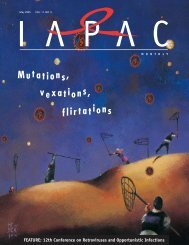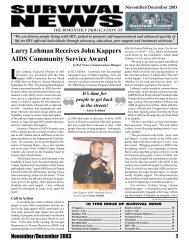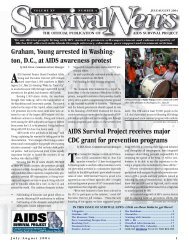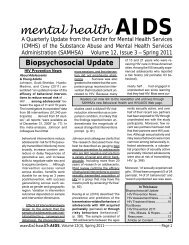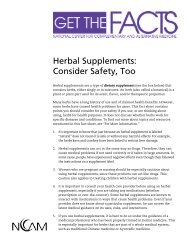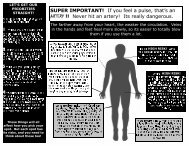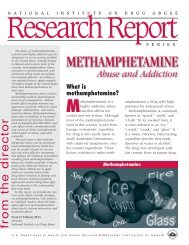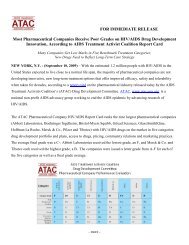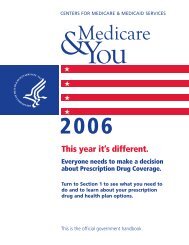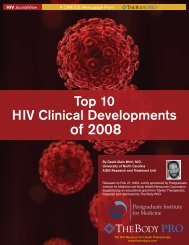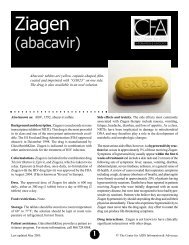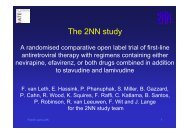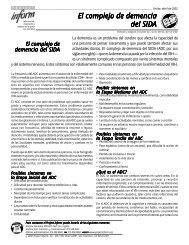Briefly - CD8 T cells - The Body
Briefly - CD8 T cells - The Body
Briefly - CD8 T cells - The Body
Create successful ePaper yourself
Turn your PDF publications into a flip-book with our unique Google optimized e-Paper software.
given nevirapine. Some of the<br />
infants were given nevirapine<br />
along with zidovudine (AZT,<br />
brand name Retrovir). In the<br />
U.S., nevirapine is sold under<br />
the brand name Viramune.<br />
Abstract WELBC03 was<br />
presented by Dr. Charles Van<br />
der Horst of the University of<br />
North Carolina, Chapel Hill.<br />
Longer duration of nevirapine<br />
use was associated with a<br />
greater reduction in risk of<br />
HIV infection. <strong>The</strong> data was<br />
taken from 5,396 motherinfant<br />
pairs in which the infant<br />
was HIV-negative at birth.<br />
Two years ago, the<br />
World Health Organization<br />
(WHO) added the use of<br />
HIV medications to prevent<br />
mother-to-child transmission<br />
during breastfeeding, in the<br />
latest update of its treatment<br />
guidelines, based on the most<br />
current data at that time.<br />
Does PreP<br />
stoP hiV<br />
in its tRacks?<br />
Last year, studies CAPRISA<br />
004 and iPrEx found large<br />
decreases in the risk of HIV<br />
infection with the use of the<br />
HIV medication tenofovir,<br />
taken orally or topically<br />
(via skin). Such a strategy is<br />
called PrEP, for pre-exposure<br />
prophylaxis (prevention). At<br />
IAS, a poster presentation on<br />
the two studies suggested<br />
the possibility that tenofovir<br />
also may have stopped HIV<br />
infection while it was in<br />
progress.<br />
In Poster MOLBPE035,<br />
CAPRISA and iPrEx<br />
researchers presented data<br />
on study participants who<br />
seroconverted to HIV. <strong>The</strong>y<br />
went back to blood samples<br />
collected before these participants<br />
had been randomized<br />
in the study. Of the 20<br />
individuals with acute preseroconversion<br />
HIV infection<br />
before randomization (out<br />
of 266 participants who had<br />
seroconverted), the majority<br />
(17) were in the study arms<br />
that had been given placebo<br />
instead of tenofovir. According<br />
to the poster, “Assignment to<br />
receive active topical or oral<br />
PrEP was associated with an<br />
83% decrease in the detection<br />
of acute pre-seroconversion<br />
HIV infection at baseline: the<br />
reasons for the difference are<br />
unclear.”<br />
Acute pre-seroconversion<br />
infection was defined as<br />
having HIV RNA detection<br />
through viral load testing<br />
along with two negative antibody<br />
rapid tests. Antibodies,<br />
the body’s response to pathogens<br />
such as HIV entering the<br />
body, take a while to develop.<br />
According to the report,<br />
the efficacy data presented<br />
last year excluded these 20<br />
individuals who were seroconverting<br />
before the studies<br />
began, and their data is<br />
“investigated in this report to<br />
understand how PrEP might<br />
affect the earliest stages of<br />
infection.”<br />
bone<br />
fRactuRes<br />
Certain drug side effects or<br />
medical conditions found<br />
in people with HIV are<br />
continuously receiving a<br />
lot of attention, and bone<br />
problems are among them.<br />
In an analysis from the U.S.<br />
Veterans Administration (VA),<br />
researchers once again found<br />
evidence that HIV treatment<br />
may have a negative effect<br />
on bones. One thing was<br />
clear, however: the risk of HIV<br />
therapy causing bone problems<br />
was minimal compared<br />
to traditional risk factors<br />
such as older age, diabetes,<br />
smoking, Caucasian race, and<br />
hepatitis C infection.<br />
<strong>The</strong> researchers were<br />
especially interested in the<br />
cumulative effect of therapy<br />
on fractures—does the risk of<br />
fracture go up with a longer<br />
duration on HIV treatment?<br />
<strong>The</strong>y were also particularly<br />
interested in the effect of<br />
Viread (tenofovir), which has<br />
been associated with loss of<br />
bone mineral density. Viread<br />
is also found in Truvada,<br />
Atripla, and Complera.<br />
<strong>The</strong> VA looked at two time<br />
frames for this analysis—1988<br />
to 1995 and 1996 to 2009, the<br />
era of HAART (highly active<br />
antiretroviral therapy). <strong>The</strong>y<br />
looked at the medical records<br />
of 56,660 patients with HIV.<br />
Of these, 951 experienced a<br />
fracture of the wrist, hip, or<br />
first vertebra (in the spine)<br />
over the entire two time periods.<br />
Most of those fractures<br />
occurred in the HAART era,<br />
572 cases in 32,439 patients.<br />
<strong>The</strong> analysis looked at<br />
osteoporotic fractures (OF),<br />
those of bones that are<br />
weakened by osteopororsis.<br />
Of note, these fractures were<br />
inferred, not confirmed,<br />
using a record coding system<br />
that the VA has validated.<br />
Moreover, they point out<br />
that they did not actually<br />
look at bone mineral density<br />
(BMD) itself, which has been<br />
the primary concern in HIV.<br />
Decreased BMD, indicating<br />
osteoporosis, has been associated<br />
with HIV therapy and<br />
with the virus itself.<br />
Over the entire time frame,<br />
the risk of fracture with exposure<br />
to antiretrovirals was statistically<br />
significant for Viread<br />
and boosted protease inhibitors<br />
(PIs). However, when<br />
factoring in other risk factors<br />
(such as hepatitis C) or other<br />
antivirals, that association<br />
went away. In the HAART era<br />
alone, the association with<br />
Viread use continued when<br />
looking at the drug by itself<br />
or in multivariate analysis with<br />
either traditional risk factors<br />
or traditional risk factors plus<br />
the use of other antivirals. All<br />
in all, there was a cumulative<br />
12% to 16% greater risk of OF<br />
per year of Viread use.<br />
Presenter Dr. Roger<br />
Bedimo of the University of<br />
Texas Southwestern Medical<br />
Center said, “<strong>The</strong> significant<br />
increase seen in the HAART<br />
era is not necessarily cause<br />
and effect.” <strong>The</strong> research<br />
team hypothesized that the<br />
cause of the increased risk<br />
of OF was aging made possible<br />
by longer survival with<br />
HAART.<br />
<strong>The</strong> presentation was<br />
complex. To see the slides<br />
and hear the audio, see<br />
http://pag.ias2011.org/flash.<br />
aspx?pid=314<br />
P O s i t i V E lyAwA R E . C O M N O V E M B E R + D E C E M B E R 2 0 1 1 | 21



